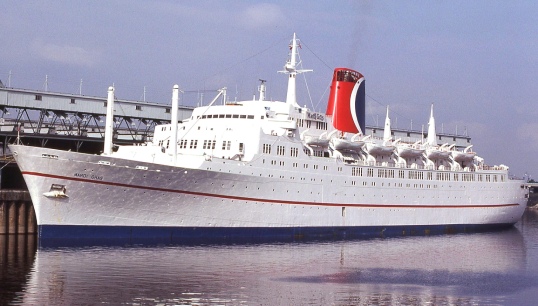Empress of Canada

The build
Delivered to Canadian Pacific in March 1961, Empress of Canada was built at the Vickers-Armstrong High Walker yard on the Tyne and was the last liner constructed for CP’s Liverpool to Montreal service.
The 27,284grt ship was powered by six steam turbine engines driving twin screws, and had a service speed of 21 knots. 650ft (198m) loa. The vessel could accommodate 192 first class and 856 tourist class passengers, with a crew of up to 510.
Deployments
When Empress of Canada came into service, transatlantic travel was starting the shift from sea to air. Therefore, CP decided to deploy the vessel on cruises in the Caribbean and Mediterranean during the winter months.
By 1969, Empress of Canada completed just seven transatlantic trips – down from more than 20 a year at its peak. After completing its 121st crossing in November 1971, the ship was put up for sale by CP, which deemed the service as no longer viable despite reports that it ran at more than 80% capacity during the previous year.
Empress of Canada was sold in January 1972 to the US businessman Ted Arison, who had fallen out with his Norwegian Cruise Line co-founders and was seeking to launch a rival operation – which became Carnival.
Mardi Gras
Renamed Mardi Gras and switched to the Panama flag, the ship left Tilbury for Miami at the end of February 1972 – with departure delayed for two days by National Union of Seamen protests over ‘the growing menace of crews of convenience’.
With little cash to spare, Carnival gave the ship a minimal refit before it began its first cruise on 11 March 1972. The company’s logo is said to have resulted from the Canadian Pacific funnel markings being slightly modified and repainted because they were too expensive to remove.
The inaugural voyage didn’t go well, with Mardi Gras running aground while departing Miami. The 530 passengers were kept supplied with food and drink while efforts were made to free the vessel – helping to fuel the ‘Fun Ships’ image fostered for the Carnival fleet.
In 1975, Carnival acquired its second ship – another former CP liner, Empress of Britain, renamed Carnivale – and by 1987 the company was claiming to be carrying more passengers than any other operator. Mardi Gras had finally received a major refit in 1982 and between 1990 and 1993 operated cruises between Port Canaveral and the Bahamas, in tandem with Carnivale.
The final years
With Carnival expanding its fleet with purpose-built ships, Mardi Gras was sold to the Greek operator Epirotiki in 1993 but was chartered to a Texas-based company to run a series of unsuccessful gambling cruises.
Renamed Apollon and bought by Royal Olympic Cruises in 1995, the ship was briefly on charter to Direct Cruises in 1999 for cruising out of the UK. Subsequent service alternated between Mediterranean cruises, serving as an accommodation vessel and periods in lay-up before Royal Olympic decided repair and refit costs were too much and the ship was sent for scrapping at Alang, India, in December 2003.
Empress of Canada fact file
What two other names did Empress of Canada go by?
Empress of Canada was renamed to Mardi Gras in 1972 and Apollon in 1993
How fast was Empress of Canada?
Empress of Canada had a service speed of 21 knots
What year was Empress of Canada scrapped?
Empress of Canada was scrapped in 2003
Contribute
Are you knowledgeable about this vessel?
Submit your contribution to this article to our editorial team.
Write to usView more ships of the past
HMS Beagle
Launched 200 years ago, HMS Beagle has been described as one of the most important ships in history – thanks to the observations on evolution and natural selection that its famous passenger Charles Darwin made during a five-year voyage around the world between 1831 and 1836.
Common.ReadMoreHMS Beagle
Oxfordshire
The Oxfordshire had a 34-year long career as an emigrant ship, passenger liner and cruiseship.
Common.ReadMoreOxfordshire
Ruahine
Entering into service just over 70 years ago, the Ruahine was the last passenger-carrying ship built for the New Zealand Shipping Company (NZSC), and the third to bear the name – which means 'wise woman' in Māori.
Common.ReadMore